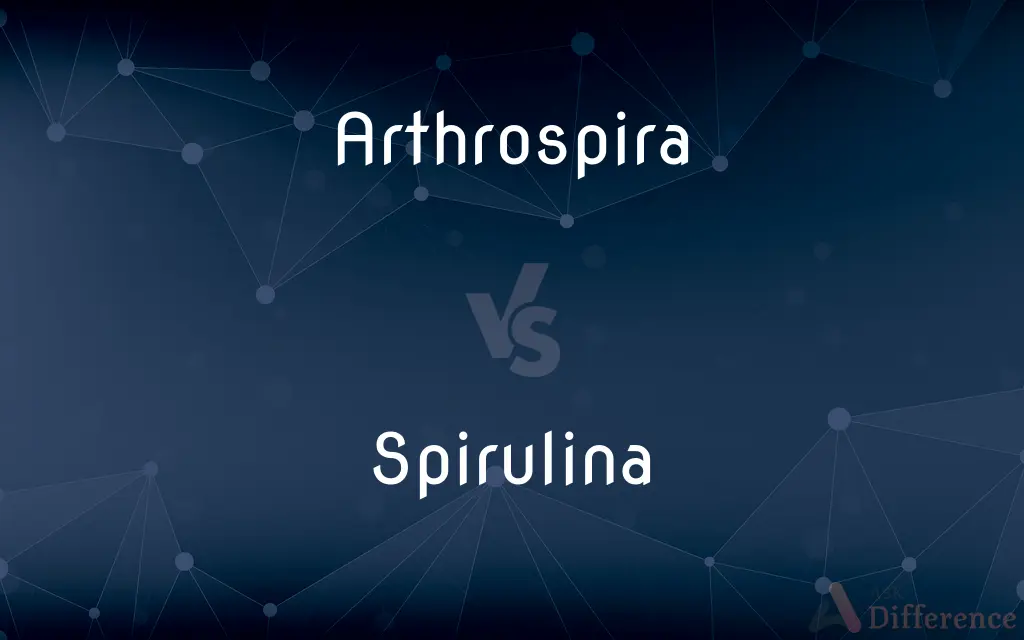Arthrospira vs. Spirulina — What's the Difference?
Edited by Tayyaba Rehman — By Fiza Rafique — Updated on April 16, 2024
Arthrospira refers to a genus of free-floating filamentous cyanobacteria, while Spirulina is a dietary supplement derived mainly from Arthrospira species.

Difference Between Arthrospira and Spirulina
Table of Contents
ADVERTISEMENT
Key Differences
Arthrospira is a genus of cyanobacteria recognized for its helical structure, which is filamentous and free-floating. On the other hand, Spirulina is commonly known as a health supplement made from dried biomass of Arthrospira, specifically A. platensis and A. maxima.
In scientific taxonomy, Arthrospira belongs to the order Oscillatoriales and is primarily found in alkaline waters of subtropical and tropical areas. Whereas Spirulina is not a taxonomical category but a commercial name used for products containing processed Arthrospira.
Arthrospira naturally thrives in high pH environments and forms dense populations that are visible to the naked eye. Conversely, Spirulina is harvested, dried, and processed into powders, tablets, or flakes for consumption, focusing on its high protein and nutrient content.
While Arthrospira itself is used in some traditional foods like the Kanembu's dihé, Spirulina has gained global popularity as a superfood supplement, praised for its potential health benefits including immune support and antioxidant properties.
Arthrospira can be cultivated in controlled environments which mimic its natural alkaline habitats to optimize growth and nutrient content. On the other hand, Spirulina products are often fortified with additional nutrients to enhance their dietary benefits.
ADVERTISEMENT
Comparison Chart
Classification
Genus of cyanobacteria
Commercial name for dietary supplements
Form
Filamentous, helical strands in water
Powder, tablets, or flakes
Habitat
Natural alkaline lakes
Cultivated in controlled freshwater environments
Usage
Research and traditional foods
Dietary supplements, health food products
Nutritional Content
High in proteins, vitamins, minerals
Often fortified with extra nutrients
Compare with Definitions
Arthrospira
Used in biofuel production.
Arthrospira's lipid content makes it a potential candidate for sustainable biofuel.
Spirulina
Available in various forms like powders and tablets.
Spirulina powder can be added to smoothies for an extra nutrient kick.
Arthrospira
A genus of cyanobacteria known for its helical shape.
Scientists study Arthrospira for its ability to produce high-value biochemicals.
Spirulina
A dietary supplement derived from cyanobacteria.
Many athletes use Spirulina to boost their energy levels.
Arthrospira
Source of natural pigments.
Arthrospira produces phycocyanin, a pigment used in food and cosmetics.
Spirulina
Marketed as a superfood.
Spirulina is popular in health food stores for its rich protein content.
Arthrospira
Known to grow in alkaline environments.
Arthrospira thrives naturally in the high pH conditions of Lake Chad.
Spirulina
Used in health and wellness products.
Spirulina face masks are trending in skincare routines.
Arthrospira
Studied for its health benefits.
Arthrospira is researched for its nutritional impact on immune health.
Spirulina
Known for its antioxidant properties.
Spirulina supplements are recommended for their antioxidant effects.
Arthrospira
Arthrospira is a genus of free-floating filamentous cyanobacteria characterized by cylindrical, multicellular trichomes in an open left-hand helix. A dietary supplement is made from A. platensis and A. maxima, known as spirulina.
Spirulina
Any of several cyanobacteria of the genus Arthrospira (formerly Spirulina) that are grown in bulk, dried, and used as nutritional supplements for their high levels of protein, vitamins, and minerals.
Spirulina
A food supplement prepared from blue-green algae of the genus Arthrospira found in soda lakes.
Common Curiosities
What is Arthrospira?
Arthrospira is a genus of filamentous cyanobacteria known for its spiral shape and ability to thrive in alkaline water bodies.
Is Spirulina safe for everyone to consume?
Spirulina is generally safe but may cause adverse reactions in individuals with certain allergies or health conditions; consultation with a healthcare provider is recommended.
What are the health benefits of consuming Spirulina?
Benefits include boosting the immune system, reducing inflammation, and potentially reducing cholesterol levels.
What does Arthrospira look like?
Arthrospira appears as long, thin, helical, blue-green strands that are free-floating in water.
Where is Arthrospira found?
It is typically found in tropical and subtropical alkaline lakes with high pH levels and high concentrations of carbonate and bicarbonate.
Can Arthrospira be used in cooking?
Yes, it's used in some traditional dishes and can also be added to modern recipes for a nutritional boost.
Can Arthrospira be eaten directly from natural sources?
While it can be consumed, Arthrospira from natural sources usually undergoes processing to ensure safety and enhance nutritional value.
How is Spirulina processed?
Spirulina is harvested, dried, and then processed into forms such as powders, tablets, or flakes suitable for dietary use.
What forms does Spirulina come in?
It is available as a powder, tablet, capsule, or flake form.
What is Spirulina used for?
Spirulina is used primarily as a dietary supplement for its high nutrient content, including proteins, vitamins, and antioxidants.
Is there a difference in the nutritional content between Arthrospira and Spirulina?
The nutritional content is similar, but commercial Spirulina products may be fortified with additional nutrients.
How is Arthrospira different from Spirulina?
Arthrospira is a specific genus of cyanobacteria, while Spirulina refers to the dietary products derived from Arthrospira species.
Why is Arthrospira considered important in scientific research?
It is studied for its potential in biofuel production, nutritional supplements, and as a model organism in photosynthesis research.
How does Spirulina taste?
Spirulina has a slightly nutty, seaweed-like taste, which is why it is often mixed into juices or smoothies.
How sustainable is Spirulina as a dietary supplement?
Spirulina is considered highly sustainable due to its low requirement of land and water resources compared to traditional crops.
Share Your Discovery

Previous Comparison
Refrain vs. Reframe
Next Comparison
Dense vs. ThickAuthor Spotlight
Written by
Fiza RafiqueFiza Rafique is a skilled content writer at AskDifference.com, where she meticulously refines and enhances written pieces. Drawing from her vast editorial expertise, Fiza ensures clarity, accuracy, and precision in every article. Passionate about language, she continually seeks to elevate the quality of content for readers worldwide.
Edited by
Tayyaba RehmanTayyaba Rehman is a distinguished writer, currently serving as a primary contributor to askdifference.com. As a researcher in semantics and etymology, Tayyaba's passion for the complexity of languages and their distinctions has found a perfect home on the platform. Tayyaba delves into the intricacies of language, distinguishing between commonly confused words and phrases, thereby providing clarity for readers worldwide.













































